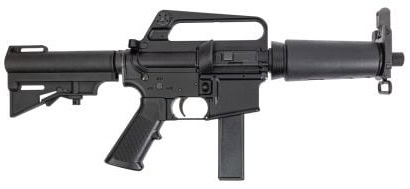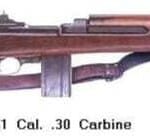
Introducting the H&R DOE 9mm AR Pistol
In the shadowy world of Cold War-era federal security operations, few firearms reflect the convergence of tactical necessity, government contract secrecy, and evolving firearm design quite like the Colt Model 633—a compact 9mm submachine gun built for the U.S. Department of Energy’s security teams. Now, four decades later, its spirit lives on in a faithful reproduction: the H&R DOE 9mm AR pistol, produced by Palmetto State Armory under the storied Harrington & Richardson (H&R) name.
Far from a standard pistol-caliber carbine or generic AR variant, this firearm tells a layered story—one rooted in Cold War nuclear defense logistics and revived in modern clone culture. With its unmistakable silhouette and niche historical significance, the H&R DOE pistol stands as both a shooter’s tool and a collector’s time capsule.
Cold War Security and the Birth of the Colt Model 633
During the 1980s, American defense policy extended far beyond foreign theaters. The Department of Energy (DOE), tasked with the protection and transportation of nuclear weapons and radioactive material, required specialized equipment to support its armed convoys and facility security teams. These units, part of the Office of Secure Transportation (OST), moved high-value cargo through populated regions—often under heavy secrecy, tight coordination, and the constant specter of terrorism or sabotage.
In this environment, traditional service rifles like the M16 were too long and too powerful for close-quarters defense inside vehicles or secure compounds. What DOE needed was a compact, controllable, and familiar platform—ideally something chambered in 9mm for reduced recoil and overpenetration, but maintaining the ergonomics of the AR-15/M16 family.
Colt’s solution was the Model 633, a dedicated 9mm submachine gun. This was not simply a caliber conversion; the Model 633 featured several purpose-built adaptations to meet the DOE's strict specifications:
- 7-inch barrel, ideal for maneuverability in tight quarters.
- Blowback-operated action, unlike the gas-impingement of standard ARs.
- Closed bolt operation, ensuring reliability and consistent point-of-impact in both semi- and full-auto modes.
- Fixed A1 carry handle upper receiver, preserving familiar iron sights.
- M231-style ribbed handguards, borrowed from the firing port weapon used in Bradley IFVs.
- Telescoping stock, to reduce length when stowed in vehicles.
- Compatibility with Colt-pattern straight 9mm magazines, usually 32-round capacity.
These were select-fire submachine guns, issued in small quantities and never made available to the civilian market. The number produced remains unclear—likely in the low hundreds. Their issuance was limited to specialized federal units, and their presence in the field has always been shrouded in the bureaucratic opacity of DOE operations.
Inside the Original DOE SMG: Design Features That Defined a Purpose-Built Protector
The Colt Model 633 wasn’t just a quick adaptation of the AR platform—it was purpose-engineered for a specific mission. Here’s a closer look at the technical design that made this weapon ideal for close-quarters federal security work:
1. Compact 7-Inch Barrel
The 7-inch barrel delivered sufficient velocity for 9mm loads while maintaining an extremely compact footprint. This allowed agents to maneuver efficiently inside vehicles, armored cabs, or corridors without snagging or overextending the weapon.
2. Blowback Action with Heavy Buffer
Unlike the gas-impingement system found in standard M16 rifles, the Model 633 used a straight blowback system, relying on bolt mass and spring pressure to delay rearward motion. A heavy buffer was essential to ensure safe, reliable cycling without gas ports or a locking bolt. This system was rugged, easy to maintain, and well-suited to the 9mm cartridge.
3. Closed-Bolt Firing System
Unlike earlier open-bolt SMGs (e.g., the MAC-10), the Model 633 fired from a closed bolt, reducing movement during ignition and providing significantly better accuracy. This was especially valuable when firing short, controlled bursts or single precision shots in close quarters.
4. Fixed Carry Handle and A1 Sights
A nod to the classic AR-15 profile, the upper receiver retained the fixed carry handle with an A1-style rear sight aperture. While primitive by today’s optic-heavy standards, this setup was robust and familiar to military-trained operators.
5. M231-Style Ribbed Handguards
Unique among AR-pattern weapons, the DOE’s Model 633 used handguards derived from the M231 Port Firing Weapon. Ribbed for grip and reinforced with internal heat shields, they provided both functionality and a distinctive appearance, setting the weapon apart from conventional carbines.
6. Telescoping Two-Position Stock
The original SMG featured a collapsible stock, not unlike early Colt CAR-15 designs. While the modern PSA variant uses a pistol brace, the original's adjustable stock made for a compact package that could expand for stable shoulder-fired use.
7. Magazine System
Feeding from straight Colt-pattern 32-round 9mm magazines, the Model 633 integrated a dedicated magwell adapter inside its lower receiver. These magazines were purpose-built and offered excellent reliability—critical for missions that required unquestioned function.
This configuration provided the DOE with exactly what it needed: a controllable, compact submachine gun with a familiar manual of arms and enough precision to avoid collateral damage in sensitive environments.
The Modern Revival: Palmetto State Armory and JJE Capital Holdings
In recent years, retro firearms have experienced a major resurgence. From A1-style M16 clones to “GUU-5/P” carbines, enthusiasts and builders have embraced the aesthetics, performance, and history of vintage military arms. Riding this wave, JJE Capital Holdings, the parent company of Palmetto State Armory (PSA), acquired the rights to several dormant firearms brands—most notably, Harrington & Richardson (H&R).
As part of the brand’s relaunch, PSA introduced a pistol that closely replicates the look and feel of the Colt Model 633, marketed under the revived H&R name. Though not a true reproduction of any weapon H&R ever made, this new H&R-branded pistol pays homage to the DOE submachine gun with remarkable visual and mechanical accuracy—minus the select-fire capability.
Modern Specifications: The PSA H&R DOE 9mm AR Pistol
The new H&R DOE 9mm pistol is built around a modern semi-automatic-only lower receiver and optimized for both historical accuracy and range performance. Key features include:
- Barrel: 7.5-inch 4150 chrome-moly vanadium, nitrided for durability.
- Upper Receiver: Slick-side A1 carry handle, with integrated rear sight—faithful to 1980s DOE configuration.
- Handguards: Ribbed DOE-style two-piece handguard with aluminum heat shields, mimicking the M231 profile.
- Action: Straight blowback system, designed for 9mm operation—robust and easy to clean.
- Brace: HAR-15 adjustable pistol brace in lieu of a stock, legally classifying it as a pistol while preserving the silhouette of the original.
- Threaded Muzzle: 5/8x24 threading for suppressor or muzzle device attachment.
- Magazines: Accepts standard Colt-pattern 9mm AR magazines; PSA typically includes a 32-round unit.
The result is a firearm that not only looks the part but delivers practical utility. Its compactness, reliability, and soft recoil make it ideal for recreational shooting, training, and historical clone builds.
Clone Culture, Collectability, and the H&R Rebirth
The H&R DOE 9mm AR pistol has found a new home among retro firearms enthusiasts and builders participating in the growing “clone culture.” This community—obsessed with period-correct gear, accessories, and configurations—embraces weapons like the DOE pistol not just for their looks but for the slice of history they represent.
While original Colt Model 633s are exceedingly rare and subject to strict National Firearms Act (NFA) restrictions, the PSA/H&R version offers a legal and accessible alternative. For those pursuing a 1980s federal look—perhaps paired with vintage optics, web gear, or suppressors—the DOE pistol is a compelling base.
Conclusion: A Revival Rooted in Respect
The H&R DOE 9mm AR pistol is not a gimmick. It is a carefully crafted revival of a forgotten government submachine gun that once protected some of the most dangerous cargo on American soil. Though Harrington & Richardson did not make the original, its name now rides again, affixed to a gun that captures the spirit of 1980s federal security operations.
Palmetto State Armory and JJE Capital Holdings deserve credit for resurrecting a weapon that was never commercially available and offering it to a new generation. Whether you’re a collector, a historical reenactor, a clone builder, or simply a shooter who appreciates compact, effective firearms, the H&R DOE pistol stands ready—once again—at the quiet crossroads of history and firepower.
Palmetto State Armory can be found here.
Now also available in .300 Blackout here.
Join the discussion on Palmetto State Armory at their user forums, found here.
If you know of any forums or sites that should be referenced on this listing, please let us know here.




